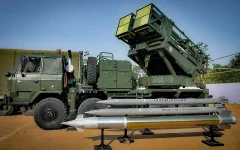- Views: 2K
- Replies: 14
Russia has reportedly put forward an offer to supply India with the advanced R-37M hypersonic long-range air-to-air missile for its fleet of Su-30MKI fighter jets. This development could significantly enhance the Indian Air Force's (IAF) air defence capabilities.
The R-37M, also known by its NATO codename AA-13 Axehead, is recognized for its impressive strike range of 300 to 400 kilometres and its ability to travel at Mach 6, six times the speed of sound. This places it among the most capable beyond-visual-range missiles globally.
The proposal, noted in online discussions and various media reports, arrives as India seeks to strengthen its aerial dominance amidst ongoing regional security considerations involving Pakistan and China.
Developed by Russia's Vympel Design Bureau, the R-37M is engineered to target and neutralize critical aerial assets such as Airborne Warning and Control Systems (AWACS), refuelling tankers, and enemy fighter aircraft.
Its primary advantage lies in allowing the launching aircraft to engage targets from a considerable distance, thereby staying out of reach of enemy air defences.
The missile employs a jettisonable rocket booster to achieve its extended operational range, which significantly surpasses the roughly 100-kilometre range of India's current R-77 air-to-air missiles.
With a hypersonic speed approaching 7,400 kilometres per hour, the R-37M can rapidly close in on fast-manoeuvring targets, making evasion extremely difficult for adversaries.
The R-37M weighs approximately 510 kilograms and is armed with a 60-kilogram high-explosive fragmentation warhead designed to inflict substantial damage.
It incorporates a sophisticated guidance system that uses inertial navigation with mid-course updates from the launching aircraft, followed by active radar homing for the final attack phase.
This "fire-and-forget" capability means the missile can independently track its target after launch, allowing the pilot to focus on other threats or defensive manoeuvres.
The R-37M is currently compatible with several Russian aircraft, including the Su-30, Su-35, Su-57, MiG-31BM, and MiG-35. Russia has proposed integrating this missile system with India’s fleet of 272 Su-30MKI fighters, which are also scheduled for comprehensive upgrades.
This offer is particularly relevant given India's experiences during the 2019 Balakot aerial engagement. During this incident, the IAF perceived a capability gap in long-range air-to-air missiles when a MiG-21 Bison was downed in combat with a Pakistani F-16, which was armed with the AIM-120C AMRAAM missile possessing a range greater than 100 kilometres.
Discussions online suggest that the R-37M could provide a decisive counter to Pakistan's F-16 fleet, enabling engagement from well within Indian airspace. Furthermore, its extended reach is seen as a crucial asset to counter the expanding air capabilities of China, including its J-10C fighters.
Russia's proposal reportedly includes the potential for manufacturing the R-37M missiles in India under the "Make in India" initiative. This aligns with India's strategic goal of achieving greater self-reliance in defence production and could further strengthen the long-standing defence partnership between India and Russia.
Reports suggest that Hindustan Aeronautics Limited (HAL) facilities could be involved in the production, possibly as part of a larger defence package.
However, integrating the R-37M onto the Su-30MKI would necessitate significant upgrades to the aircraft's existing radar and fire-control systems, as the missile's maximum range of 400 kilometres may exceed the detection capabilities of the Su-30MKI's current Bars radar.
The R-37M has seen operational use by Russian forces in the conflict in Ukraine since 2019, deployed from Su-35S, Su-30SM2, and MiG-31BM aircraft. There are reports of the missile achieving a kill against a Ukrainian MiG-29 from a distance of 213 kilometres in 2024.
While some assessments indicate that the missile has not secured a large number of confirmed "hard kills" (complete destruction of the target), its launch often forces adversary aircraft to abort their missions and take defensive evasive actions. This highlights its strategic value in disrupting enemy air operations.
The missile's design, featuring folding tail controls and mid-body strakes, contributes to its extended range and adaptability for carriage on various aircraft, including an internal carriage version (Izdeliye 810) designed for the Su-57 stealth fighter.



